 |
|
| Grand Forks Air Force Base
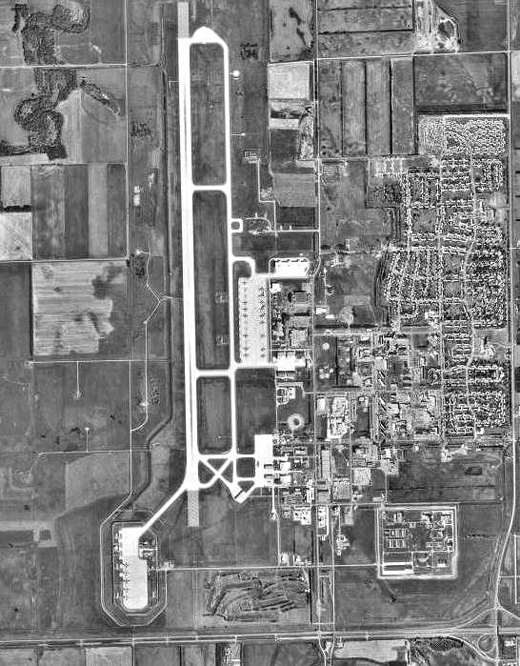
Air Mobility Command
|
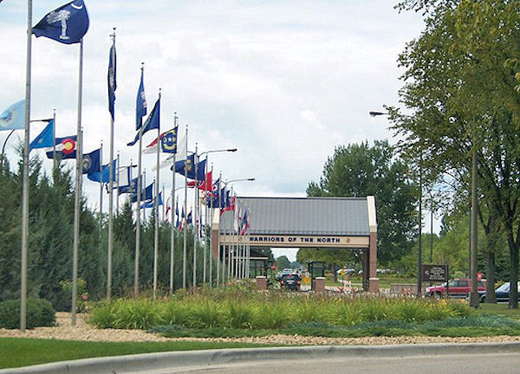 |
| USGS aerial image - September 17, 1997 |
| IATA: RDR – ICAO: KRDR – FAA LID: RDR |
| Summary |
| Airport type |
Military: Air Force Base |
| Owner |
United States Air Force |
| Operator |
Air Mobility Command |
| Location |
Grand Forks County, near Emerado, North Dakota |
| Built |
1956 |
| In use |
1957–present |
| Occupants |
319th Air Refueling Wing |
| Elevation AMSL |
913 ft / 278 m |
| Coordinates |
47°57′40″N 097°24′04″W / 47.96111°N 97.40111°W / 47.96111; -97.40111 |
| Website |
www.grandforks.af.mil |
| Runways |
| Direction |
Length |
Surface |
| ft |
m |
| 17/35 |
12,350 |
3,764 |
Asphalt |
| Source: FAA and official web site |
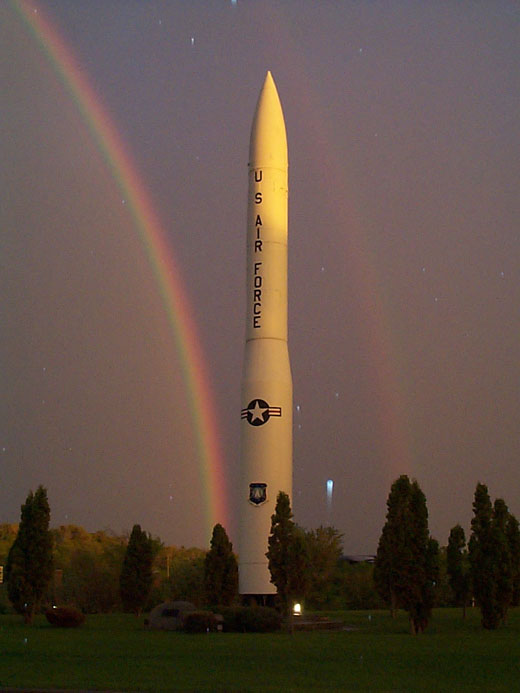 | |
Main Gate at Grand Forks AFB |
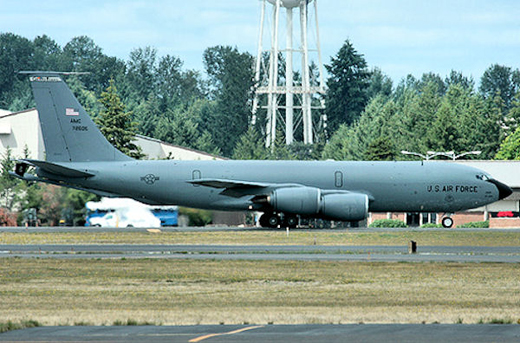 | |
LGM-30 Minuteman III missile on display at the entrance of GFAFB. |
Grand Forks Air Force Base (AFB) (IATA: RDR, ICAO: KRDR, FAA LID: RDR) is a United States Air Force base located near Emerado, North Dakota and approximately 16 miles (26 km) west of Grand Forks, North Dakota.
The host unit at Grand Forks is the 319th Air Refueling Wing (319 ARW) assigned to the Air Mobility Command Eighteenth Air Force. The 319th guarantees global reach and engagement for the U.S. and its allies through robust air refueling and airlift capabilities.
Grand Forks AFB was established in 1955. The 319th Air Refueling Wing is commanded by Colonel Donald L. Shaffer. The wing Command Chief Master Sergeant is Chief Master Sergeant Scott A. Fuller. Overview
Grand Forks AFB is the home of the Air Mobility Command (AMC) 319th Air Refueling Wing (319 ARW).
The city of Grand Forks has a population of close to 50,000 and is home of the University of North Dakota. It is located in the Heart of the Red River Valley near the forks of the Red Lake River and the Red River of the North.
Units
The 319th Air Refueling Wing is organized into four distinct groups: Operations, Maintenance, Support and Medical.
- 319th Operations Support Squadron
- 905th Air Refueling Squadron
- 319th Maintenance Squadron
- 319th Maintenance Operations Squadron
- 319th Mission Support Group
- 319th Civil Engineer Squadron
- 319th Communications Squadron
- 319th Contracting Squadron
- 319th Logistics Readiness Squadron
- 319th Force Support Squadron
- 319th Security Forces Squadron
- 319th Medical Operations Squadron
- 319th Medical Support Squadron
Tenant Units at Grand Forks AFB are:
- Air Force Office of Special Investigations
- 10th Space Warning Squadron
- 373d Training Squadron
- United States Customs and Border Protection (operating RQ-1 Predators)
History
Grand Forks Air Force Base was established in 1955, with construction beginning in the fall of that year. It was occupied for use on 28 January 1957.
Major commands to which assigned
- Air Defense Command, July 25, 1956
- Central Air Defense Force
- Strategic Air Command, July 1, 1963
- Air Mobility Command, June 1, 1992 – present
Base operating units
- 478th Air Base Sq, 28 January 1957
- 478th Air Base Gp, 1 February 1961
- 319th Combat Support Gp, 1 July 1963
- 804th Combat Support Gp, 22 October 1964
- 321st Combat Support Gp, 1 August 1972-30 September 1998
- 319th Mission Support Group, 1 October 1998–present
Major units assigned
- 478th Fighter Group, February 8, 1957 – December 28, 1960
- Redesignated: 478th Fighter-Day Wing, December 28, 1960 – July 1, 1963
- Grand Forks Air Defense Sector, December 8, 1957 – December 1, 1963
- 4133d Strategic Wing, September 1, 1958 – February 1, 1963
- 18th Fighter-Interceptor Squadron, May 1, 1960 – April 15, 1971
- 905th Air Refueling Squadron, February 1, 1960 – present
- 319th Bombardment Wing (Heavy), February 1, 1963 – October 1, 1993
- Redesignated: 319th Air Refueling Wing, October 1, 1993 – present
- 4th Air Division, September 1, 1964 – June 30, 1971
- 321st Strategic Missile (later Missile) Wing (later Group), November 1, 1964 – September 30, 1998
- 804th Combat Support Group, August 18, 1964 – July 31, 1972
References for history introduction, major commands and major units
Operational history
Due to the continuance of the Cold War between the U.S. and the Soviet Union, Grand Forks AFB was originally built as an Air Defense Command (ADC) fighter-interceptor air base. The site for the base was chosen in 1954 and the land was paid for by the citizens of Grand Forks, the site was located 15 miles (24 km) west of the city. The beginning of the 5,400-acre (22 km) air base started in 1956 with the construction of a 12,300-foot (3,700 m) runway. In 1957, the air base brought the 478th Fighter Group into service. Between 1957 and 1959, the Grand Forks Air Defense Sector of NORAD and SAGE became operational, which was able to cover three U.S. states and one Canadian province.
In 1958, the 4133rd Strategic Wing (4133 SW) was activated, which would soon add both KC-135 Stratotanker refueling aircraft and B-52 Stratofortress bombers to the unit. 1960 was an important year for GFAFB when the 905th Air Refueling Squadron (905 ARS), the 18th Fighter-Interceptor Squadron (18 FIS), and the 478th Fighter Wing (478 FW, which replaced the 478th Fighter Group) were all activated.
In 1962, GFAFB accepted the 30th Bombardment Squadron with B-52Gs from Homestead AFB, Florida and incorporated it into the 4133d Strategic Wing. In 1963, the 319th Bombardment Wing (319 BW) activated, replacing the deactivated 4133rd Strategic Wing. In the same year, the Grand Forks Air Defense Sector and the 478th Fighter Wing were also deactivated, as the base's host switched to the Strategic Air Command (SAC). The 321st Strategic Missile Wing (321 SMW) was also established in November 1963 as the first LGM-30 Minuteman II intercontinental ballistic missile wing in SAC.
In 1971, the 18th Fighter-Interceptor Squadron was deactivated and the 460th Fighter-Interceptor Squadron replaced the unit. The 804th Combat Support group was soon deactivated in 1972, and in 1973 the upgrade of the Minuteman III missiles to 321 SMW was completed. In 1974, although the 460th Fighter-Interceptor Squadron won first place at the William Tell Air-to-Air Competition at Tyndall AFB, Florida, it was deactivated due to the restructuring of the air defense system.
In December 1986, the last B-52Gs permanently departed GFAFB, replaced by the B-1B Lancer in 1987. A change in the host unit occurred again, when in 1988, the 42nd Air Division was assigned for base support in place of the 321st SMW.
The next decade would bring some of the biggest changes to GFAFB. In 1991, the 42nd Air Division was deactivated. SAC was officially deactivated on June 1, 1992, and the base initially became part of the newly established Air Combat Command (ACC). The base was later transferred to the new Air Mobility Command (AMC) in 1994 following the departure of the last B-1B aircraft, redesignation of the 319 BW as the 319th Air Refueling Wing (319 ARW) and associated transfer of KC-135 aircraft assets to AMC, and transfer of strategic ICBM assets to Air Force Space Command (AFSPC). The 321 SMW was downgraded to a missile group in early 1995 and deactivated entirely in 1998. GFAFB's first ICBM silo was imploded in accordance with the Strategic Arms Reduction Treaty (START II) in 1999 and the last silo imploded in 2001.
Starting at the beginning of 2011, Grand Forks will also station a detachment of RQ-4 Global Hawks. It remains unclear as to whether these will be new aircraft or ones transferered from Beale AFB CA, Edwards AFB CA, or Creetch AFB NV.
Base realignment, 2005
In May 2005, DoD recommended to the BRAC Commission that GFAFB should be realigned. This would prevent the base from being closed, but would result in a significant loss in personnel levels as well as a loss of the tanker mission. To make up for these losses, the Air Force has decided to assign RQ-4 Global Hawks to Grand Forks, the first of which are due to arrive mid-2011. As of May 2010, there has not been an official announcement concerning whether or not the base will transition from Air Mobility Command to another MAJCOM. It has also been speculated that Grand Forks is being considered as a potential home to the new KC-X tanker.
DemographicsIt is part of the "Grand Forks, ND-MN Metropolitan Statistical Area" or "Greater Grand Forks". As of the 2000 census, the base CDP had a total population of 4,832. According to the United States Census Bureau, the base has a total area of 8.2 square miles (21.2 km²), all land.
As of the census of 2000, there were 4,832 people, 1,279 households, and 1,230 families residing on the base. The population density was 590.5 people per square mile (228.1/km²). There were 1,516 housing units at an average density of 185.2/sq mi (71.6/km²). The racial makeup of the base was 80.86% White, 8.40% Black or African American, 0.89% Native American, 2.42% Asian, 0.31% Pacific Islander, 2.67% from other races, and 4.45% from two or more races. Hispanic or Latino of any race were 5.98% of the population.
There were 1,279 households out of which 77.3% had children under the age of 18 living with them, 88.5% were married couples living together, 4.1% had a female householder with no husband present, and 3.8% were non-families. 3.0% of all households were made up of individuals and none had someone living alone who was 65 years of age or older. The average household size was 3.41 and the average family size was 3.48.
On the base the population was spread out with 38.4% under the age of 18, 20.4% from 18 to 24, 39.4% from 25 to 44, 1.7% from 45 to 64, and 0.1% who were 65 years of age or older. The median age Was 22 years. For every 100 females there were 115.0 males. For every 100 females age 18 and over, there were 123.9 males.
The median income for a household on the base was $36,414, and the median income for a family was $36,104. Males had a median income of $24,413 versus $17,750 for females. The per capita income for the base was $11,503. About 4.0% of families and 4.2% of the population were below the poverty line, including 3.6% of those under the age of 18 and none of those 65 and older.
Timeline
- 1954 The Department of Defense chose Grand Forks as the site for a new installation.
- February 5, 1956 Contractors begin construction of the base.
- February 8, 1957 Air Defense Command (ADC) activated the 478th Fighter Group at Grand Forks AFB as the host unit for the base.
- September 1, 1958 Strategic Air Command (SAC) activated the 4133d Strategic Wing (Provisional) as a tenant unit at Grand Forks AFB.
- December 15, 1959 The Grand Forks Air Defense Sector of the North American Air Defense Command became operational with the Semi Automatic Ground Environment (SAGE) System.
- May 1, 1960 The 18th Fighter-Interceptor Squadron (FIS) was stationed at Grand Forks AFB with its F-101B Voodoos.
- May 6, 1960 The 905th Air Refueling Squadron (ARS) (Heavy), a unit assigned to the 4133d Strategic Wing, received its first KC-135A Stratotanker.
- December 28, 1960 The 478th Fighter Wing was activated under the ADC and became the host unit for the base.
- April 29, 1962 The 30th Bombardment Squadron, a unit assigned to the 4133d Strategic Wing, received its first B-52H Stratofortress.
- February 1, 1963 Strategic Air Command organized the 319th Bombardment Wing (Heavy) at Grand Forks AFB. The 319 BMW became the host wing as the 4133d Strategic Wing deactivated and command of the base transferred from the ADC to SAC.
- August 19, 1964 Strategic Air Command activated the 804th Combat Support Group (CSG) as the host unit at Grand Forks AFB.
- September 1, 1964 Strategic Air Command stationed the 4th Air Division, later named 4th Strategic Aerospace Division, at Grand Fork AFB.
- November 1, 1964 The 321st Strategic Missile Wing (SMW) was organized at Grand Forks AFB and construction began on its Minuteman II missile complex.
- December 1966 The 321 SMW became operational with the Minuteman II missile.
- April 15, 1971 Air Defense Command deactivated 18 FIS.
- June 30, 1971 The 4th Strategic Air Division transferred to Francis E. Warren AFB, Wyoming.
- July 1, 1971 The 321 SMW assumed host unit duties from the 804 CSG.
- July 30, 1971 Air Defense Command stationed the 460th Fighter-Interceptor Squadron, with F-106 Delta Darts, at Grand Forks AFB.
- March 8, 1973 The 321st Strategic Missile Wing completed an upgrade to Minuteman III missiles.
- 1974 The ADC deactivated the 460 FIS.
- 1986–1987 The 319th Bombardment Wing converted from the B-52G Stratofortress and KC-135A Stratotanker to the B-1B Lancer and KC-135R Stratotanker.
- June 16, 1988 Strategic Air Command transferred the 42d Air Division (AD) to Grand Forks as the host support unit for the base.
- July 9, 1991 Strategic Air Command deactivated the 42 AD and appointed the 319th Bombardment Wing as the host unit for the base.
- September 1, 1991 The 319th Bombardment Wing was redesignated as the 319th Wing. The 321st Strategic Missile Wing was redesignated as the 321st Missile Wing (MW).
- June 1, 1992 The Air Force deactivated the Strategic Air Command and reassigned Grand Forks AFB to the Air Combat Command. The 319th Wing was redesignated as the 319th Bomb Wing. The 905 ARS was reassigned to the Grissom AFB, Indiana, although it continued to operate from Grand Forks AFB.
- July 1, 1993 The 321 MW was reassigned to Air Force Space Command.
- October 1, 1993 The Air Force redesignated the 319th Bomb Wing as the 319th Air Refueling Wing, reassigned it to Air Mobility Command, and reassigned the 905th Air Refueling Squadron to the wing.
- 1994 As part of restructuring at Grand Forks the Air Force reassigned the 906th, 911th, and 912th Air Refueling Squadrons to Grand Forks AFB.
- May 26, 1994 The last B-1B Lancer departed from Grand Forks AFB, marking the end of over 30 years of bombers at Grand Forks.
- July 1, 1994 Air Force Space Command redesignated the 321 MW as the 321st Missile Group (MG).
- October 1, 1995 The Clinton Administration approved the Base Realignment and Closure IV committee's recommendation to remove 150 Minuteman III intercontinental ballistic missiles from the Grand Forks Air Force Base missile complex and deactivate the 321st Missile Group.
- April 1997 After a long, harsh winter, the Grand Forks area suffered a devastating flood due to snowmelt and spring rain. Members of the Grand Forks Air Force Base were called into action, first to help protect the town from the rising waters and later to house the victims of the disaster.
- July 2, 1998 The 321st Missile Group deactivated after 34 years of service at Grand Forks AFB.
- October 6, 1999 The first missile silo was demolished in accordance with the Strategic Arms Reduction Treaty (START).
The above content comes from Wikipedia and is published under free licenses – click here to read more.
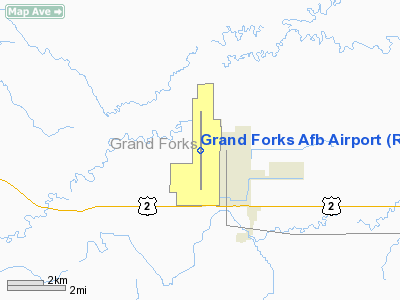
Location & QuickFacts
| FAA Information Effective: | 2008-09-25 |
| Airport Identifier: | RDR |
| Airport Status: | Operational |
| Longitude/Latitude: | 097-24-04.2000W/47-57-40.2000N
-97.401167/47.961167 (Estimated) |
| Elevation: | 913 ft / 278.28 m (Estimated) |
| Land: | 0 acres |
| From nearest city: | 13 nautical miles W of Grand Forks, ND |
| Location: | Grand Forks County, ND |
| Magnetic Variation: | 06E (1995) |
Owner & Manager
| Ownership: | Air Force owned |
| Owner: | Usaf |
| Address: | Grand Forks Afb
Grand Forks, ND 58201 |
| Manager: | Base Operations |
| Address: | Grand Forks Afb
Grand Forks, ND 58201 |
Airport Operations and Facilities
| Airport Use: | Private |
| Wind indicator: | Yes |
| Segmented Circle: | No |
| Control Tower: | Yes |
| Lighting Schedule: | DUSK-DAWN |
| Beacon Color: | Clear-Green (lighted land airport) |
| Sectional chart: | Twin Cities |
| Region: | AGL - Great Lakes |
| Boundary ARTCC: | ZMP - Minneapolis |
| Tie-in FSS: | GFK - Grand Forks |
| FSS on Airport: | No |
| FSS Toll Free: | 1-800-WX-BRIEF |
| NOTAMs Facility: | GFK (NOTAM-d service avaliable) |
Airport Services
| Fuel available: | 115 B+ |
| Airframe Repair: | MAJOR |
| Power Plant Repair: | MAJOR |
| Bottled Oxygen: | NONE |
| Bulk Oxygen: | LOW |
Runway Information
Runway 17/35
| Dimension: | 12350 x 150 ft / 3764.3 x 45.7 m |
| Surface: | ASPH, |
| Pavement Class: | 139/R/A/W/T |
| Weight Limit: | Single wheel: 155000 lbs.
Dual wheel: 280000 lbs.
Dual tandem wheel: 470000 lbs. |
| Edge Lights: | High |
| |
Runway 17 |
Runway 35 |
| Elevation: | 899.00 ft | 911.00 ft |
| ILS Type: | LOC/GS
| ILS
|
| Traffic Pattern: | Right | Left |
| Markings: | Precision instrument, | Precision instrument, |
| Arresting: | | BAK9B |
| VASI: | 4-light PAPI on left side | 4-light PAPI on left side |
| Approach lights: | ALSF1 | ALSF1 |
| Runway End Identifier: | No | No |
| Centerline Lights: | No | No |
| Touchdown Lights: | No | No |
|
Radio Navigation Aids
| ID |
Type |
Name |
Ch |
Freq |
Var |
Dist |
| CKN | NDB | Crookston | | 400.00 | 07E | 32.5 nm |
| RDR | TACAN | Red River | 111X | | 06E | 0.3 nm |
| GFK | VOR/DME | Grand Forks | 090X | 114.30 | 09E | 8.7 nm |
| TVF | VOR/DME | Thief River Falls | 021X | 108.40 | 08E | 49.3 nm |
Remarks
- JASU: (AM32A-86) (AM32-95)
- CAUTION: UNCTL VEH TFC ON TWY AND RAMPS.
- RSTD: ALL INBD PAX/CARGO ACFT MUST CTC COMD POST NO LATER THAN 30 MIN PRIOR TO LDG. ACFT WITH DGR MATERIALS CTC PTD 30 MIN PRIOR TO ETA.
- FUEL: J8
- FLUID: SP PRESAIR LHOX
- OIL: OIL AVBL IN PACKAGE PRODUCT ONLY, HAND TRANSFER RQR. O-133-148
- TFC PAT: OVERHEAD 2400', RECTANGULAR 1900'. VFR OVERHEAD AND RECTANGULAR TFC PAT RGT HAND RWY 17. TRAN VFR ACFT INBD TO THE OVERHEAD PAT PROCEED TO INITIAL AT OR ABV 3200'.
- MISC: ACFT WITH VHF RDO EQPT ONLY MAY CTC BASE OPS THRU ATC. NO HGR SPACE. BASE OPS DSN 362-4409, C701-747-4409. ALL ACFT WITH DV ON BOARD CTC COMD POST 60 NM PRIOR LDG.
- MISC: TWY AND RAMPS HAVE SIGNIFICANT FOD POTENTIAL. WX INFO AVBL CTC DSN 362-4396. ACFT RON CTC COMD POST 24 HR PN, DSN 362-6871, FOR BILLETING.
- TRAN AIRCREWS WHO RON, FAX CREW ORDERS TO COMD POST DSN 362-6894 PRIOR TO ARR.
- PMSV METRO: WX SVC AVBL 1200-0500++MON-FRI; CLSD SAT-SUN. COMBAT WX FLIGHT DSN 362-4396, C701-747-4396. BLDG OBSTN MAY IMPACT PREVAILING VIS 010‘-220‘. ATC WILL ENHANCE SFC OBSN WHEN TWR VIS IS LESS THAN 4SM AND DIFFERENT THAN RPT VIS.
- PMSV METRO: DUR EVAC OF COMBAT WX SQUADRON CTC 15 OPERATIONAL WX FLIGHT AT NR BLW. REMOTE BRIEFING SVC AVBL FROM 15 OPERATIONAL WX SQUADRON, SCOTT AFB DSN 576-9755, C618-256-9755.
- TRAN ALERT: NO FUEL SVC AFTER 0415++ WKD.
- MISC: FIRST/LAST 1100 FT OF RWY 35/17 IS CONCRETE. MIDDLE 10150 FT OF RWY 35/17 IS ASPHALT.
- RSTD: ALL ACR OPS EXCP CIV ACRS ARE SUBJECT TO RESTRICTIONS AND POTENTIAL DELAYS DUR BASH PHASE II, SEP THRU NOV, APR THRU JUN AND OTHER TIMES AS DETERMINED BY THE CURRENT BIRD WATCH CONDITION (BWC).
- RSTD: BWC MODERATE PROS ARE IN EFFECT DURING THE PHASE II BASH WINDOWS (1 HR PRIOR TO 1 HR AFTER SUNRISE AND 1 HR PRIOR TO 1 HR AFTER SUNSET). WHEN BWC IS MODERATE OR GREATER: NO IFR/VFR TFC PAT IS PERMITTED AND ANY TKOFS OR LDGS RQR OG/CC APVL.
- RSTD: AIRPORT ACFT WILL CTC TWR OR AFLD OPS FOR THE CURRENT BWC AND THE OG/CC THRU COMMAND POST (NORDIC CONTROL 311.0) DURING PERIODS OF BWC MODERATE FOR WAIVER AUTH IN ORDER TO TKF OR LAND.
- BEARING STRENGTH RWY 17-35: ST175, SBTT620, TT470, SWL65 & PSI650.
Images and information placed above are from
http://www.airport-data.com/airport/RDR/
We thank them for the data!
| General Info
|
| Country |
United States
|
| State |
NORTH DAKOTA
|
| FAA ID |
RDR
|
| Latitude |
47-57-39.954N
|
| Longitude |
097-24-04.301W
|
| Elevation |
911 feet
|
| Near City |
GRAND FORKS
|
We don't guarantee the information is fresh and accurate. The data may
be wrong or outdated.
For more up-to-date information please refer to other sources.
|
 |



